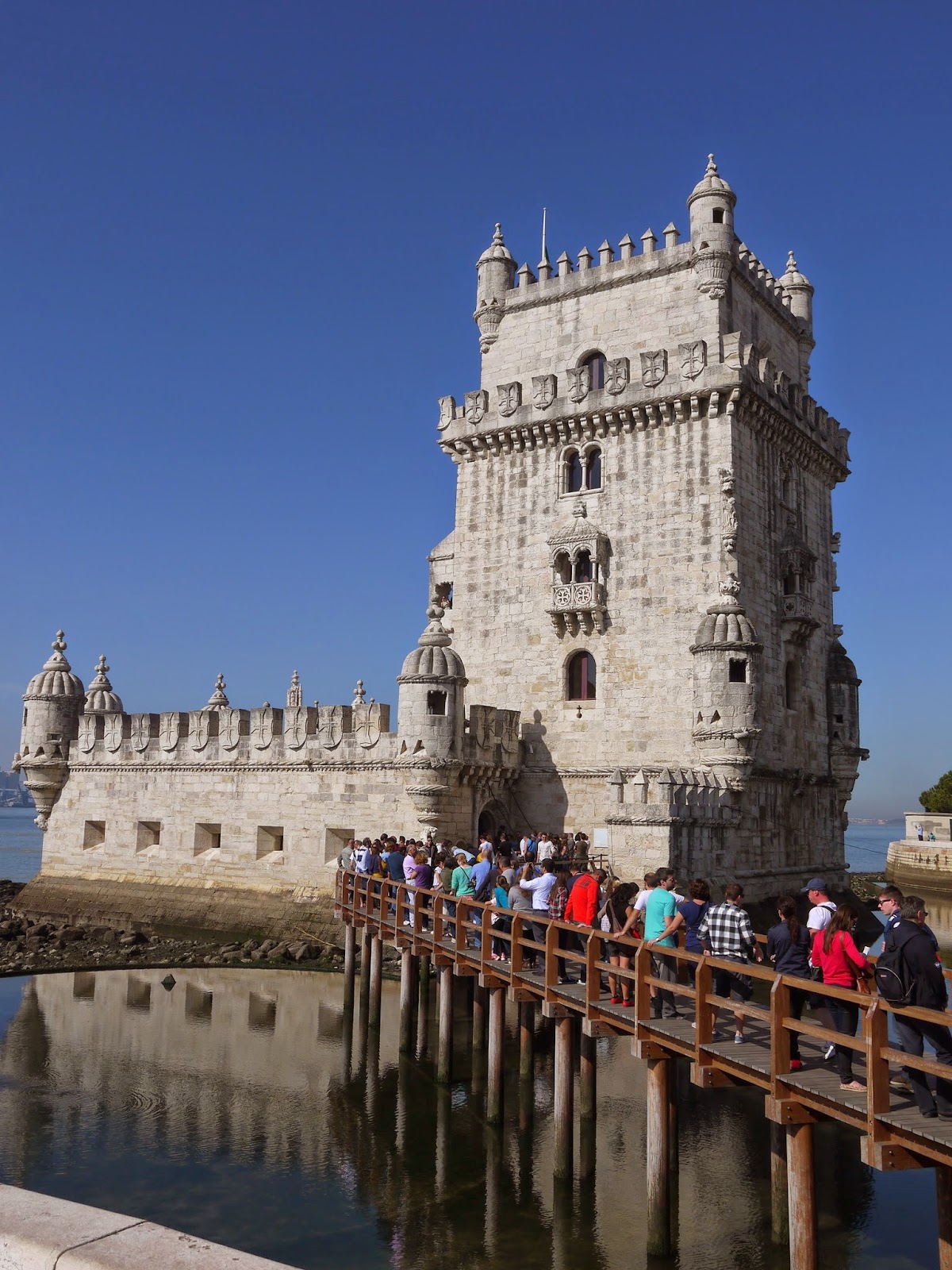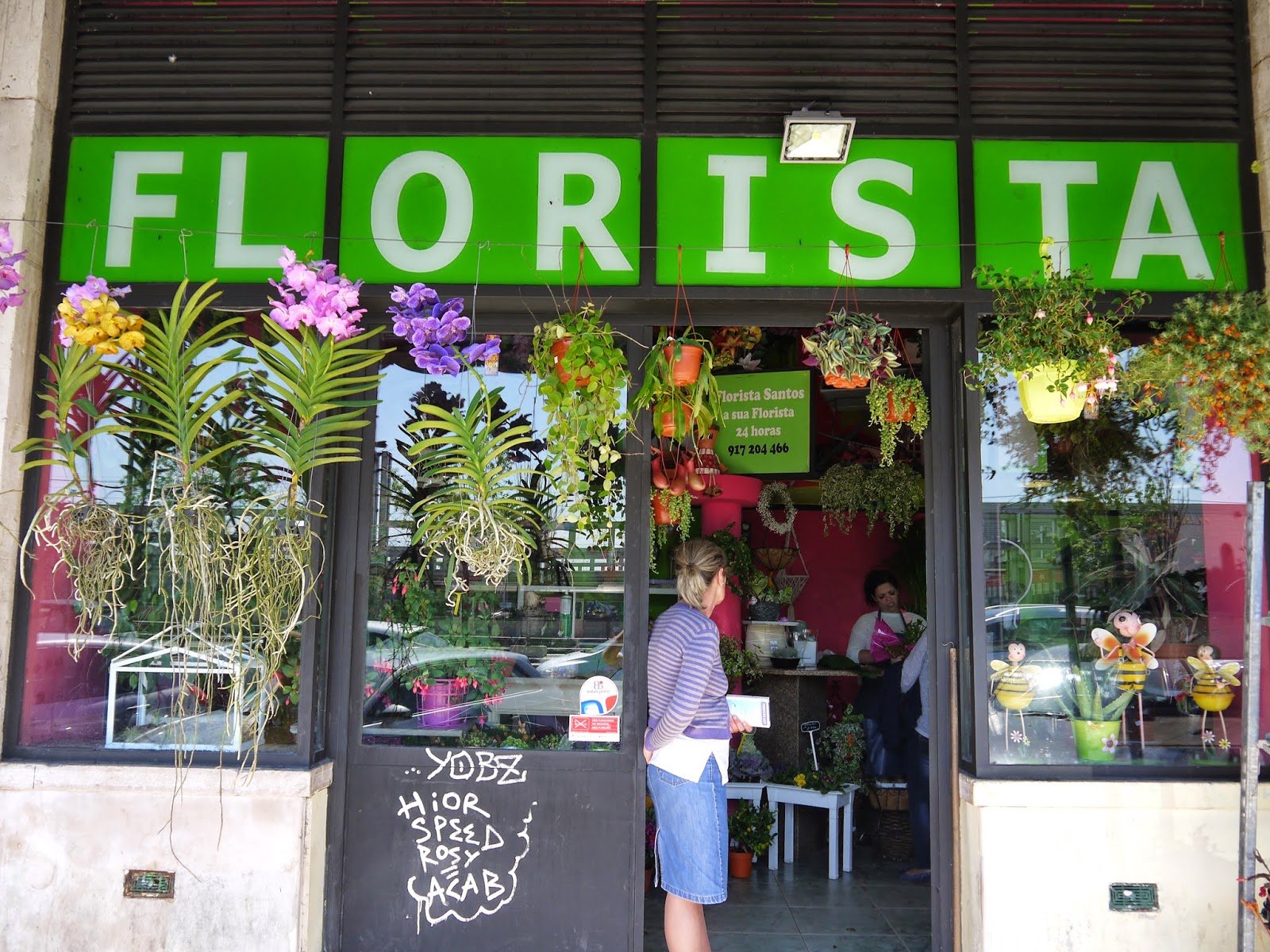I was recently in Lisbon for the first time. I had planned to visit several years ago and for various reasons couldn't go. Having spent four nights there, I can't believe I waited so long to go and would love to spend some more time there soon.
The city has some major tourist attractions, but regular readers will know that my favourite destinations have great cafes, interesting architecture, galleries and museums, a little shopping, a chance to hear local jazz musicians perform and great opportunities for strolling and enjoying the city. Lisbon has all of these and this post includes some of my favourites.
I managed to combine shopping and my favourite drink at
A Carioca, a tiny shop at Rua da Misericordia 9, from where the smell of freshly ground coffee has been wafting into the street since the 1930's. The shop was acquired by the long established Negrita company in 1990 and restored to its original art deco influenced glory. Customers choose their favourite coffee beans which are then ground on the original machine filling the shop with rich aromas. I was lucky enough to be able to buy arabica beans imported from the former Portuguese colony of
Sao Tome e Principe. Fragrant and delicious. As well as a great range of coffees, chocolate and sweets,
A Carioca also sells the famous
Gorreana tea, grown in the Azores using traditional methods. The shop offers good old fashioned service and a glimpse of how Lisbon must have been 80 years ago.
 |
| A Carioca, coffee stores, Rua de Misericordia |
Still on the coffee theme, Lisbon has hundreds of cafes, the most well known of which is Cafe a Brasileira on Rua Garrett. Established in 1905 to sell "genuine Brazilian coffee", owner Adriano Telles gave a free cup of it to every customer who purchased one kilo of ground coffee. His idea caught on and 110 years later, despite some difficulties in the 1950's Brasileira sells thousands of cups of coffee every day. Now mainly patronised by tourists, the cafe was once the haunt of Portugal's best writers and artists including poet
Fernando Pessoa whose statue stands outside.
The interior was redesigned in 1922 by architect Jose Pacheco with mosaic marble floors, ornamental freezes on the ceiling, walls in reds, ochres and golds and ornate mirrors and wooden pillars. The entrance references art nouveau with its figures and flourishes including a gentleman enjoying a cup of coffee. There is also a tiny and charming wooden panelled kiosk just inside the doorway where you can buy newspapers, magazines, cigarettes, postcards and other bits and pieces. Yes, the cafe is full of tourists but is still worth a visit to enjoy the decor and a good cup of coffee standing at the bar. Coffee must be accompanied by one of the ubiquitous
pastel de nata, tiny delicious custard tarts. I love custard tarts but these knock spots off the shop bought ones found in the UK.
 |
| Cafe A Brasileira, Rua Garret |
 |
| The Discoveries Monument, Belem |
The pastels are thought to have originated before the 18th century, made by the Catholic monks at the iconic
Jeronimos Monastery in the Belem district. The pastels can be purchased at almost any pastel aria in the city but the best ones are said to be made at the
Pasteis de Belem in Rua Belem. The length of the queue outside of the shop on the Sunday morning I visited appears to vouch for this! If you manage to get to the front of the queue and enjoy your pastels, Belem is a great place for strolling to burn off the calories. The Jeronimos Monastery and the 16th century Belem Tower are key elements in the area's UNESCO World Heritage Site listing. The Tower in particular features on many postcards, travel guide covers, fridge magnets and other tourist paraphernalia. It also attracts huge queues at weekends and holidays and wanting to make the most of my time, I opted instead to go to the top of the nearby Discoveries Monument, built in 1960 overlooking the River Tagus and featuring Leopoldo de Almeida's sculptures of various Portuguese royals and explorers including
Magellan, de Gama and
Cabral. Best of all is the view over Belem and the Tagus from the top of the 50 metres tall structure.
 |
| The Belem Tower |
On the subject of strolling, there are some great themed guided walks available from
Lisbon Walker who offer a whole series of different walks every day. I took the City of Spies walk which takes participants back to the 1940's and the Second World War, where due to Portugal's neutral status and Lisbon's important geographic location, the city was flooded with spies from both allied and axis powers as well as refugees seeking a way out of Europe. Different cafes and hotels would attract clientele from opposite sides whilst in some establishments it was possible to find German and British agents eating at adjoining tables. I was thrilled to learn that my hotel, the Avenida Palace had been frequented by spies from both sides mainly due to the direct and private corridor to the adjoining Rossio Station which allowed discrete entrance and exit!
Many, although not all, of the refugees were Jews from German occupied territories, desperate to leave Europe. Many were poor and depended on charitable organisations including the
Joint Distribution Committee for sustenance, whilst others were more wealthy. One of the richer "guests" was none other than art collector
Peggy Guggenheim who is said to have shocked conservative Lisbon by entering cafes unaccompanied, something felt to be beyond the pale in those days whilst other women refugees wearing short dresses, again a rarity amongst respectable Portuguese women at the time, became a major talking point amongst the Portuguese.
Pastelaria Suica occupies a prominent position in Praca dom Pedro in the city centre. Refugees needed to pass through the square on their way to the various offices that could issue them papers to leave Europe. Local men soon became wise to this and renamed the cafe the "Good Legs Cafe" as they sat outside admiring the refugee women passing by. Neil Lochery's
Lisbon: War in the shadows on the city of light 1939-45 tells the full story of this little known chapter of European history.
 |
| Moorish design, Casa do Alentejo |
One of the venues much favoured by agents of both sides was the former casino in the Palacio de Alverca on Rua das Portas de Santo Antao. Built in the 17th century in Moorish style with gorgeous arches, tiles and stained glass, it must have been the perfect setting for intrigue and espionage with its roulette wheels, card games and dancers on a the double sided stage that allowed patrons in adjoining rooms to be entertained at the same time! The Palacio is still there and is now the home of the
Casa do Alentejo, a cultural centre for the Alentejo region of Portugal with a restaurant serving its traditional food. It is easy to walk in from the street and admire the courtyard and the staff don't seem to mind visitors having a peep at the exquisite upstairs rooms too.
 |
| The Courtyard, Casa do Alentejo |
Most of the Jews who came through the city as refugees eventually moved on to the Unites States, Israel or other countries. Today, Portugal has a small Jewish population with 7000 people identifying as Jewish in a recent census. Lisbon has just one synagogue and visitors are welcomed. It is the place of worship for the 750 or so registered members of the community. Built in 1904, as in many European cities, it is tucked away, behind a metal gate on Rua Alexandro Herculano. I was shown around by Ana Araujo who co-ordinates visit to the synagogue . She told me a little about the history of the Jews in Portugal including the expulsion in 1496, the horrors of the
Inquisition and the interesting story of the
Marranos, mostly forced converts to Catholicism but who secretly maintained at least some Jewish religious practices over centuries. A community of
Marranos in Belmonte, northern Portugal, re-established itself as a full Jewish community in 1989. There is a
minyan at the Lisbon synagogue on shabbat and also on the major Jewish holidays. There is no rabbi at the moment although there are visits by rabbis from other European countries that have larger communities. The synagogue itself has a beautiful interior with wooden panelling and seats and an extremely ornate
Aron HaKodesh with beautiful Hebrew letters, Magen Davids and colourful mosaic details.
 |
| The synagogue, Rua Alexandro, Herculaneo |
Two final places I must mention -
Corvo Azul, a tiny little gourmet close to the Sao Jorge Castle that sells great preserves, pickles, soaps and other Portuguese products and which offers friendly service and advice and is a great place to pick up little treats to take home - the fig jam I purchased was very well received! Corvo Azul is the kind of place I would visit every week if I lived in this city! My other favourite shopping experience was
A Vida Portuguesa in Rua Anchieta. This is a delightful place full of Portuguese produced items, including soaps, porcelain, stylish Serrotte notebooks, cleaning materials, rugs, blankets, books and music. I liked it so much I visited twice during my short stay and came away loaded up with blankets, a vinyl record, some postcards, soaps, toothpaste and some exquisite
Alantoine hand cream for my mum!
Lisbon is a great city in which to spend a few days and to discover on foot, whilst the easy to use metro makes most of the city easily accessible by public transport. As ever, there was so much to see in so little time.
A few more pictures to enjoy...
 |
| Colourful houses in Alfama |
 |
| Street scene, Alfama |
 |
| Blossom in Alfama |
 |
| Florist near Estacio de cams de Sodre |







No comments:
Post a Comment